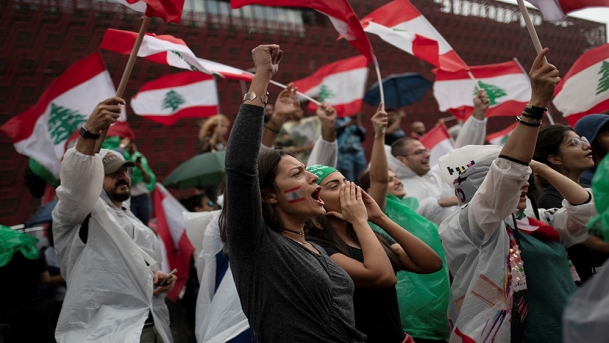
On 17 October 2019, mass popular protests erupted in Lebanon after the government announced a raft of new taxes, including a bump in the VAT and a new tax on the use of WhatsApp. These demonstrations mark a departure from previous mass protests in 2015 and 2005. Most significantly, the protests have crossed confessional boundaries and the conventional fault lines of regional conflicts and alignments, as demonstrators direct their ire at the elite political class as a whole. And they have not only demanded an end to corruption and cronyism, but the resignation of the prime minister, the president, and the speaker of the house, the ruling troika of the confessional system created by the Taif Accords. Unlike previous protests, the current demonstrations are not confined to Beirut, but have erupted all over the country, and both the middle class and the poor are heavily represented.
The magnitude and fervour of the protests is partly explained by socioeconomic factors, most significantly rising income inequality. The top 0.1 percent of Lebanese earns as much as fully half the population, and sluggish to no economic growth means there is less wealth to be distributed, even as some sectors, like banking, have continued to be highly profitable. At the same time, record levels of inflation have dramatically increased the cost of living.
These economic dysfunctions cannot be separated from the nature of the Lebanese political system. The confessional system has given rise to a class of political elites who rule based on connections and patronage, without oversight or accountability. The resulting waste and corruption costs the country an estimated 9 percent of GDP annually. The longevity of the protests, their cross-confessional nature, and the protestors’ grievances all suggest that the political system created by the Taif Accords is in crisis.
Political factions’ response to the uprising has ranged from calculated support to severe reservations verging on rejection. The Progressive Socialist Party and the Lebanese Forces have come out in support of the protests, but both parties and their leaders have personal reasons for doing so, having often complained of being side-lined in the current government.
Hezbollah, Amal, the Future Movement, and the Free Patriotic Movement oppose the protestors’ rejection of the political system as a whole, warning of an institutional vacuum and of various local and foreign powers hijacking the protests, while promising to meet the demonstrators’ economic demands and institute anti-corruption measures and reforms. The stance of Hezbollah, the most crucial player due to its regional role, is representative of the ruling coalition partners. In a speech, Hezbollah leader Hassan Nasrallah suggested that his party had long sought the same goals as the protestors, but that the nature of the Lebanese system had stymied its efforts. But there is no doubt that Hezbollah views the latest protests as a direct threat to its own popular legitimacy, domestic influence, and regional role, and it has vowed to prevent the collapse of the current system of governance.
Whether the protests continue and what they ultimately achieve depends on whether the government can offer enough to appease or divide the protestors without ushering in an even greater economic crisis or severe unrest that could change the face of Lebanon. There are three possible scenarios for the direction of the Lebanese uprising.
First, the protests could be contained while preserving the current system by instituting a set of economic, political and legal reforms, perhaps even including a Cabinet shakeup and new parliamentary elections. Such concessions might be paired with the use of violence by both official and unofficial security forces to quell more maximalist demands. The authorities have already shown a willingness to take security measures against the uprising, for example by calling out the army to secure roads.
Second, the uprising could achieve its goal of partially or wholly undermining the post-Taif system by formulating measures to resolve the economic and political crisis and establishing mechanisms for constitutional amendments following early elections. But this cannot be achieved without a backer from within the regime and a foreign patron, neither of which is currently on offer.
The third and most dire scenario is that measures taken to quell the protests lead to severe unrest, an economic emergency, and even a civil war. This seems unlikely given the peaceful nature of the uprising, the interest of Lebanese factions in maintaining the current confessional system, the current lack of regional powers’ interest in Lebanon, and international powers’ stake in maintaining Lebanese stability.
*This is a summary of a policy brief originally written in Arabic, available here: http://studies.aljazeera.net/ar/positionestimate/2019/10/191027125458023.html